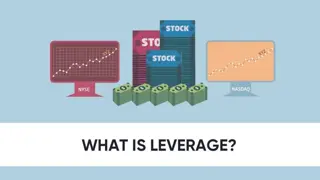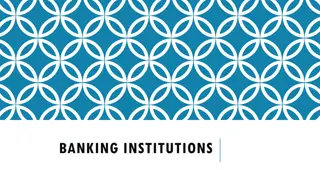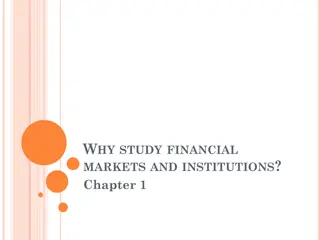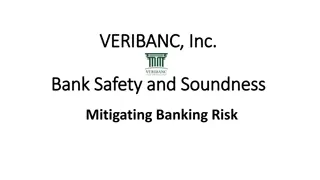Financial Systems and Institutions Overview
The key concepts of finance including financial markets, institutions, flow of funds, surplus and deficit units, financial intermediaries like commercial banks, insurance companies, and more. Learn about the role of the financial system in allocating resources and managing risks in an uncertain environment.
Uploaded on Mar 13, 2025 | 2 Views
Download Presentation

Please find below an Image/Link to download the presentation.
The content on the website is provided AS IS for your information and personal use only. It may not be sold, licensed, or shared on other websites without obtaining consent from the author.If you encounter any issues during the download, it is possible that the publisher has removed the file from their server.
You are allowed to download the files provided on this website for personal or commercial use, subject to the condition that they are used lawfully. All files are the property of their respective owners.
The content on the website is provided AS IS for your information and personal use only. It may not be sold, licensed, or shared on other websites without obtaining consent from the author.
E N D
Presentation Transcript
Financial Markets and Institutions P.V. Viswanath For a First Course in Finance
What is Finance Finance is the study of how people allocate scarce resources over time. Decisions are made across time Decisions are made in an environment of uncertainty Decisions are made in the context of a financial system P.V. Viswanath 2
Financial System The financial system is the set of markets and other institutions used for financial contracting and the exchange of assets and risks Markets for stocks, bonds and other financial instruments Financial intermediaries such as banks and insurance companies The regulatory bodies that govern all of these institutions, such as the Federal Reserve, the Securities and Exchange Commission etc. P.V. Viswanath 3
Flow of Funds The financial system allows for the transfer of funds from surplus units (such as savers) that have excess resources to deficit units, such as businesses that need resources. This can happen either through the market, as when an individual uses his savings to buy shares issued by a corporation. Or through intermediaries, as when an individual deposits money in his banking account, and the bank then lends this money to a firm. P.V. Viswanath 4
Financial System: Flow of Funds Markets Surplus Units Deficit Units Intermediaries P.V. Viswanath 5
Surplus or Deficit Are Corporations Surplus Units or Deficit Units? Deficit Units Surplus Units Both P.V. Viswanath 6
Examples of Financial Intermediaries Commercial Banks Insurance Companies Pension and Retirement Funds Mutual Funds Investment Banks Venture Capital Firms Asset Management Firms Information Service Providers P.V. Viswanath 7
Commercial Banks These are financial intermediaries that offer checking accounts, savings accounts, money market accounts and accepts time deposits. They also facilitate payments by way of telegraphic transfer, electronic funds transfer, internet banking, or other means. They make loans to businesses and consumers. They also buy corporate and government bonds. P.V. Viswanath 8
Investment Banks An investment bank is a financial institution that raises capital and advises regarding such matters, advises regarding and sells corporate insurance products like credit default swaps, trades securities and manages corporate mergers and acquisitions. It may also have a wing that does research on the prospects of companies. Some investment banks are also involved in private equity, where the bank invests its own capital. In contrast to commercial banks that deal with individuals, investment banks tend to work with corporations and governments. P.V. Viswanath 9
Venture Capital Firms Venture Capital is a type of private equity capital typically provided for early-stage, high-potential, growth companies in the interest of generating a return through an eventual realization event such as an IPO or trade sale of the company. Venture capital investments are generally made as cash in exchange for shares in the invested company. For ventures that need financing at earlier, more speculative, stages of the business, angel financing is more appropriate. Part of this information was taken from Wikipedia P.V. Viswanath 10
Asset Management Companies These include hedge funds and other mutual funds. Typically, they invest in existing securities, as opposed to investing directly in companies. For example, Halcyon uses portfolio risk managers and independent risk analysts and engages in research across capital structures, regions, and business/economic cycles; It uses both a Bottom-Up and Top-Down Investment method Individual position comparison based on risk/reward analysis Structures portfolios and allocate capital among strategies Uses attribution analysis for macro decision making and planning P.V. Viswanath 11
Regulatory Institutions Central Banks SEC, FASB and other institutions that regulate financial intermediaries or financial markets International Co-ordinating Organizations World Bank to promote international development International Monetary Fund to promote international trade and finance. Bank for International Settlements to promote uniformity of banking regulations P.V. Viswanath 12
Investment Bank Is an Investment Bank a Bank? Yes No P.V. Viswanath 13
Types of financial markets Equity Markets Fixed Income markets Money market Long-term capital market for debt securities Derivatives Options Forwards Futures P.V. Viswanath 14
Rates of Return Fixed Income Securities have promised rates of return. Thus, a bond might pay 8% per annum, i.e. for every $100 lent, the investor receives $8 per year. However, the borrower might not be able to pay the promised annual return or the principal. Hence the actual return could be less than the promised return. If an investor buys a bond for $100 on Jan. 1 and receives interest of $8 on Dec. 31. Suppose on Dec. 31, the bond drops in value to $98 because investors believe that the likelihood of the investor paying off the bond in full is less than certain. The actual return on the bond over the year is [8+(98- 100)]/100 = 6% P.V. Viswanath 15
Nominal and Real Rates of Return Suppose an investor buys a bond for $100 on Jan. 1 and receives $8 on Dec. 31. Suppose the price of the bond on Dec. 31 remains at $100. The nominal return on the bond is 8/100 or 8%. Suppose, however, that prices have risen 3%; i.e. a basket of goods that cost $100 at the beginning of the year costs $103 at the end of the year. The investor has given up one basket of goods at the beginning of the year for (100+8)/103 = 1.0485 baskets of goods at the end of the year. The real rate of return on the bond is 4.85% P.V. Viswanath 16
Expected Rates of Return Prices of traded assets are set according to the return that investors expect to get on average on their investments. If an asset is expected to be worth $120 at the end of the year, and no cash distributions are expected, then an investor desiring an expected return of $12% will pay 120/1.12 or $107.14 for the asset at the beginning of the year. (120 107.14)/107.14 = 12% P.V. Viswanath 17
Determinants of Expected Rates of Return The expected productivity of capital goods Capital goods, such as mines, roads, factories are more productive if an initial investment returns in more output at the end of the period The degree of uncertainty about the productivity of capital goods Investors dislike uncertainty; the greater the uncertainty, the greater the required expected rate of return Time Preferences of people If people dislike waiting to consume, expected returns will be higher. Risk Aversion The more people dislike uncertainty, the greater the required expected rate of return Expected Inflation The higher the expected rate of inflation, the greater the required expected nominal rate of return P.V. Viswanath 18























